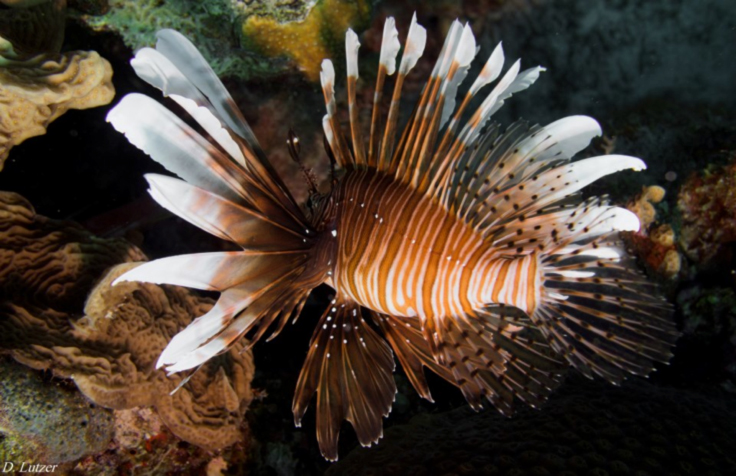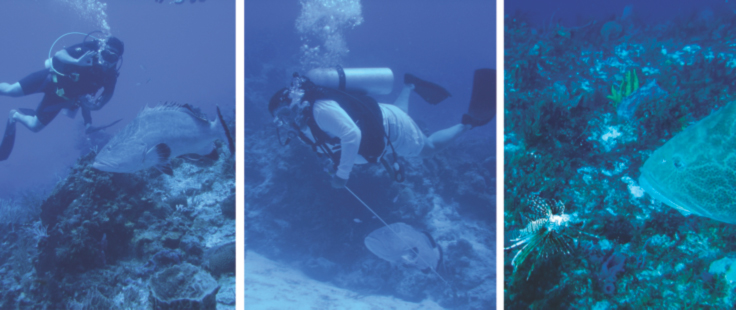Marine Life & Conservation
Marine Life – The Lionfish

Witnessing a magnificent Lionfish glide through the water with its memorizing fan-like fins provides an experience that stays in one’s memory for a lifetime. The lionfish is without a doubt one of the most graceful and intricate looking fish that you can come across.
Lionfish have several names like zebrafish, firefish, turkeyfish, and more. An adult can grow as large as 18 inches, while juveniles may be as small as 1 inch or less. The lionfish is one of the most venomous fish on the ocean floor. The venom of the lionfish is delivered through up to 18 needle-like dorsal fins. It is purely defensive and relies on camouflage and lightning-fast reflexes to capture prey of mainly shrimp and fish. A sting from a lionfish is extremely painful to humans and can cause nausea and breathing difficulties, but is rarely fatal. Give lionfish enough space and they pose no threat.
Lionfish are native to many areas from the South Pacific and Indian Oceans, western Australia and Malaysia east to French Polynesia and the United Kingdom’s Pitcairn Islands, north to southern Japan and southern Korea and south to Lord Howe Island off the east coast of Australia and the Kermadec Islands of New Zealand.
Over the recent years Lionfish have been reported far from their native homes in areas where they do not belong like the southeastern United States coast from Florida to North Carolina. I recently dove in Cozumel where lionfish have been somehow introduced to the water and should not be there. The divemasters in Cozumel are actively working to kill the lionfish; during one of my dives a friendly grouper whom the divemasters had been training to eat lionfish followed us through the entire dive like a little puppy begging for a treat. When the divemaster came across a lionfish the grouper watched over his shoulder while he killed it with a spear and then proceeded to feed it to the grouper.
The grouper at first spit it out but after the divemaster introduced it to the groupers mouth again it eventually ate it. Admitedly it was very bittersweet to witness – it was my first lionfish and I was sad to see it killed. Though bittersweet it is a good thing that the divemasters are doing this, because the lionfish have no prey in the area and are killing many fish and the reefs. They need to have a predator in order to keep them from taking over killing all that is left of the marine life in the area.
The lionfish, a beauty but yet an alien invader…
Marine Life & Conservation
Caribbean Nations Unite to Advance Marine Conservation Financing at Curaçao Workshop

Earlier this month, marine conservation leaders from across the Caribbean gathered in Curaçao for an intensive workshop focused on sustainable finance solutions for protected areas. The 3-day event, jointly organized by Blue Marine Foundation, Blue Nature Alliance, and the Dutch Caribbean Nature Alliance (DCNA), brought together marine park managers and conservation professionals from ten Caribbean islands.
Representatives from all six Dutch Caribbean islands participated alongside delegates from St. Vincent and the Grenadines, Barbados, the Dominican Republic and St. Kitts & Nevis. The workshop featured collaborative sessions, expert presentations, and strategic planning to address the critical funding challenges facing marine conservation efforts throughout the region.
Participants received insights on diverse financing mechanisms, drawing from regional and global case studies that serve as templates for the Caribbean’s unique marine ecosystems. By focusing on opportunities and collaboration, the workshop exemplified how intentional shifts can create ripple effects in conservation efforts.
“It’s been such an encouraging event,” said Clare Brook, CEO of Blue Marine. “Ten Caribbean islands have come together to share challenges and concerns, particularly grave funding and capacity shortages for vital conservation work in the region. We have emerged with a range of creative, innovative solutions which have the potential to channel meaningful finance for marine protection into the region. In our concerted effort to protect 30% of the ocean by 2030, the Caribbean Sea is becoming the ‘Sea of Hope!’”
The “30 by 30″ initiative represents a global commitment to protect at least 30% of the world’s ocean by 2030. This ambitious target aims to safeguard marine biodiversity, enhance ecosystem resilience against climate change, and secure sustainable livelihoods for coastal communities. “Meaningful change happens when we listen, collaborate, and center on the people who know these places best. At the Blue Nature Alliance, we believe conservation finance is a vital enabler, one that must support island-led priorities and scale regional solutions. The choices we make now matter, for the ocean and for every community that depends on it.” said Sarah Elsaid, Regional Lead, Blue Nature Alliance.
“The Dutch Caribbean Nature Alliance firmly believes that regional collaboration is the cornerstone of sustainable conservation funding,” said Arno Verhoeven, Director of DCNA. “This workshop has provided crucial insights into the diverse conservation strategies being implemented across Caribbean islands. By aligning our efforts, we’ve taken an important first step toward developing more robust financing mechanisms. Our shared marine ecosystem requires shared solutions.”
The workshop provided a valuable opportunity for participating nations to exchange experiences, celebrate conservation successes, and collaboratively develop strategies to overcome shared challenges. Participants departed with actionable plans to implement sustainable financing mechanisms tailored to their specific ecological and economic contexts.
About the Organizing Partners
- Blue Marine Foundation is a UK ocean conservation charity set up in 2010 by some of the team behind the award-winning documentary film ‘The End of the Line’. Blue Marine is dedicated to addressing overfishing, one of the world’s biggest environmental problems and aims to restore the ocean to health by protecting and restoring marine environments. Its mission is to ensure the effective protection of at least 30 per cent of the ocean by 2030 and the sustainable management of the whole ocean.
- Blue Nature Alliance is an ambitious global initiative working to accelerate the pace, scale, and effectiveness of 5% of the global ocean, or 18M km2, by 2027, through partner-led collaboration and innovation.
- Dutch Caribbean Nature Alliance is the regional network of protected areas and conservation organizations across the Dutch Caribbean islands of Aruba, Bonaire, Curaçao, Saba, St. Eustatius, and St. Maarten.
Marine Life & Conservation
Most people unaware of ‘forever chemicals’

A new YouGov survey, commissioned by the UK’s leading ocean membership charity, the Marine Conservation Society, has revealed public concern over the impact of PFAS, commonly known as ‘forever chemicals,’ on both the environment and human health. However, the findings also indicate that awareness of these chemicals remains relatively low among the UK public with 57% of respondents knowing nothing about forever chemicals, and even more (63%) knowing nothing about PFAS.
PFAS (per- and poly-fluoroalkyl substances) are just one group – containing thousands of individual chemicals – of ocean poisons. PFAS make products greaseproof and waterproof, so they are used in items such as cosmetics, non-stick pans, stainproof and waterproof clothing, swimwear, paints, and greaseproof takeaway containers. They are found in every UK home.

Photo: Alex Ford
Dr Francesca Ginley, Chemicals Policy and Advocacy Manager at the Marine Conservation Society, said: “I’m concerned by the lack of awareness of forever chemicals. These chemicals impact each and every one of us, every day. They are in our homes, in the sea spray and raindrops, in our favourite wildlife, and they last forever. We know they have immune, hormonal and neurological impacts on marine animals like polar bears, sea otters and harbour porpoises.”
A map of UK PFAS pollution in wildlife was published earlier this year by Watershed Investigations, the Marine Conservation Society and the Guardian, identifying official data on more than 1,000 animals to reveal widespread contamination.
PFAS can enter the environment as a result of manufacturing processes. Discarded products sent to landfill result in leaching chemicals into freshwater systems. Water treatment plants don’t currently remove PFAS, therefore they are released in treated wastewater and can also be captured in sewage sludge used to fertilise farmland. After a period of rain, this PFAS-containing sewage sludge can run off into rivers and streams, as well as entering the food chain. It all ultimately ends up in the ocean, with potentially disastrous effects on marine life.
Respondents to the YouGov survey were asked to identify which items they thought contained PFAS or forever chemicals. Among those who were aware of these chemicals, 30% could not identify any common sources of PFAS from the list provided, including non-stick pans, cosmetics, and firefighting foam. Only 24% identified drinking water as containing forever chemicals, despite a recent study showing PFAS were detected in sources at 17 of England’s 18 water firms. 25% of respondents identified greaseproof paper as containing forever chemicals, whilst the most selected item that participants identified as containing forever chemicals at 55% was non-stick pans.

Photo: Alex Ford
Overwhelmingly, respondents expressed concern about their impact, with 68% stating they were concerned about the impact of PFAS on the environment, and 60% stating they were concerned about the impact of PFAS on their health.
Dr Francesca Ginley, Chemicals Policy and Advocacy Manager at the Marine Conservation Society, said: “We need people to be aware of these chemicals and understand their impact so that they can add to our outrage and call for better protections. There is an urgent need to ban these chemicals to reduce the burden of their pollution. We are calling for the UK Government to ban all PFAS from all uses where there are alternatives, without delay.”
The survey also revealed strong public backing for tighter regulations on PFAS. 57% of respondents supported a UK Government ban on PFAS where alternatives are available, whilst only 3% opposed this idea.
The Marine Conservation Society is urging the UK Government to take immediate steps to phase out PFAS and prevent further contamination of the marine environment. The charity is launching its Big Give campaign on Earth Day (22nd April) to raise awareness and funds to support their work in campaigning against the use of PFAS.
Find out more about the Marine Conservation Society at www.mcsuk.org.
Main Image: Alex Ford

 Gear Reviews3 months ago
Gear Reviews3 months agoGear Review: SurfEars 4

 Blogs1 month ago
Blogs1 month agoGO Diving Show 2025: The Monster Mark Evans Created (And Why the Industry Loves It)

 Marine Life & Conservation1 month ago
Marine Life & Conservation1 month agoARC marine Celebrates “Commended” Award at Underwater Photographer of the Year with reef cube image

 News2 months ago
News2 months agoGo Diving Show 2025 Exhibitor Showcase

 News1 month ago
News1 month agoHumpback Mother and Calf Win Underwater Photographer of the Year 2025

 News3 months ago
News3 months ago2-for-1 tickets now available for GO Diving Show

 News2 months ago
News2 months agoFilming 360 in The Bahamas

 News2 months ago
News2 months agoBook Review: Amazing Diving Stories by John Bantin




















